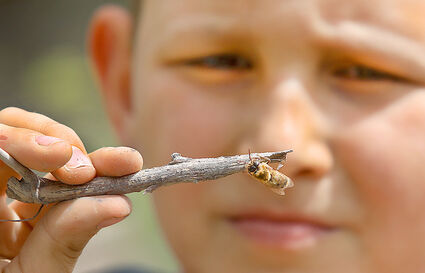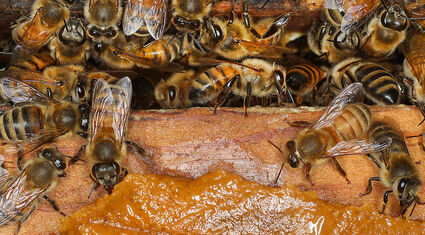4-H member's hives create buzz for beekeeping
June 2, 2022

Ed Moreth
RESEARCH – John McNamara checks out a honey bee he found on the ground outside the hive. He noticed the bee wasn't moving very fast and wanted to find out if it was a second queen of the hive. It turned out to be a drone.
Finding out that honey is basically "bee vomit" didn't deter John McNamara from eating honey and getting stung and bit by bees didn't stop him from wanting to raise bees.
The 9-year-old McNamara's dream came true when he got 10,000 honey bees to start his own two hives in early May. After letting the bees acclimate in their new home, John and his parents, Carissa McNamara and Bruce Beckstead, checked on the critters last weekend to see how they were doing.
"They looked real good," said John, who was nervous about removing the individual frames in the hive. He wasn't afraid of getting stung; he didn't want to hurt the bees. The inspection was to see if the hive was healthy, look for broods (baby bees), and make sure the queen was there. All three were happy with what they found in the two hives. Bruce and John removed the frames while Carissa operated the smoker, a device used to help calm bees. They found the queen in one of the hives, but he didn't want to stress the bees out and decided he'd look another day for the second one.
"I love bees. They're just so fascinating," said John, who finds them interesting to watch. "We sat out here for hours the other day. We were just mesmerized," said Carissa. John said he's noticed bees with orange, red and yellow pollen and said the color depends on the flower type they get the pollen from. "I love bees because they are kind," he added.
John is in his second year in 4-H as a member of the South Side Sparks club of Plains. When he started his quest for a bee hive, he was the only 4-H'er in Sanders County with a honey bee project. His enthusiasm, however, sparked interest in others and now there are a dozen members in Sanders County with an actual honey bee project, with Carissa as the project leader.
The South Side Sparks and the Thompson Falls Mountaineers have kids doing bee projects, according to Juli Thurston, the extension agent who heads the seven 4-H clubs in Sanders County. "John's the instigator of the whole thing," said Bruce, who helps with the hives, among his other responsibilities on the ranch. The kids doing honey bees range between 5 and 14 years old.
"I always am excited when 4-H can design a project that meets the interest of the kids," said Thurston. It's the first time any 4-H members have done a bee project in Thurston's six years here.Paradise resident Audrey Brown, former member of the South Side Sparks, is believed to have been the last 4-H'er to have a bee project, in 2012, and it was done as a self determined project.
John had visited the hives several times since loading them in his backyard, but he hadn't opened them up. Sunday was one of the first warm days that the bees ventured outside the hives. Carissa said they have a radius of three miles, but that they would return to the hive by nightfall. John felt the bees were getting used to him and he was certain they wouldn't sting him. "They know I'm not going to hurt them," said John, who found one larger bee on the ground near the hive, thinking it might be another queen that had hatched. If so, he'd give it to Bob Day of Bob's Montana Bees in Thompson Falls. Day has 25 bee colonies and has been a keeper for 10 years. He helped John and his family set up their colony. Day also gave a group of 4-H kids a tour of his bee colonies, the proper term for hives, on Saturday.
John got his hives set up in April when he and other 4-H kids painted their hive boxes with different pictures. Carissa said the bees would recognize their own hives because they remember its pattern. John said his bees are "Montana mutts," a cross of Carolinian and Italian species.
They bought two nucs from a bee apiarist in Arlee. A bee nuc is comprised of five frames and there are 10 frames in a hive. Half of the frames are initially empty, giving the bees room to grow their population and make honey, according to John, who wasn't so much concerned with getting honey than just having the bees for enjoyment. However, he raved about the taste of the honey when he accidentally got some on his glove Sunday. "That was such great honey. That's better than store honey," said John. He said he also wants to remove beeswax from the hives to make candles.
John is no stranger to having strange pets. He has about a dozen snakes, a tarantula, pheasants, quails, ducks, and a calf that he plans to enter in next year's 4-H beef competition. He said he has wanted to have bees since he was 6 years old while living in Utah. There was a fruit orchard near his dad's ranch, but a drought forced local bees to search for water, which they found in a water trough at John's home. He noticed that some had fallen in the water and were drowning, so one by one, he scooped them out using a turkey feather. He said the bees were crawling all over him while drying out, then flew away. He said he got stung only once, but several bit him. "It didn't really hurt much. It just kind of tickled," said John. Soon afterward he started visiting a neighbor who had bee hives and told his parents he wanted to do that.
The bee John discovered on the ground last week turned out to be a drone. "It had huge eyes. They're bigger than the queen's eyes and they don't have stingers," said John, who has been researching much about bees since getting the hives. For 4-H, he has to keep a daily journal of how he cares for them and what they do. John learned that queen bees mate with about 50 drones and lay around 3,000 eggs a day.
"The drones mate with the queen. After that, they're worthless little things," said John, who added that drones are all males. He said that in a colony there are also worker bees and guard bees. "The worker is really important. He does the wax and makes the honey, and he gets the pollen, said John. "Every bee has a job," said John, who added that when they approached the hives one day the previous week some of the guard bees came at them, although the bees went back to the hive when they backed off. He visits the hives daily and seldom bothers with any protective garb unless he's going to open the hive box. He said he can tell if the bees are angry. "If they're bouncing off my veil and gloves that means they're getting mad," said John, who doesn't like wearing the bulky gloves and said he might do it without them next time.
John learned that the biggest threats that the guards handle are yellow jackets, wasps and hornets. He and his parents are taking other precautions to protect the hives, like putting out yellow jacket and wasp traps and moving bluebird houses far from them. John said bluebirds really like bees. He said they raised the hives 18 inches above ground, which helps protect against skunks. Carissa said they'll be installing an electric fence around the hives for protection against bears.
John said one of his hives is more calm than the other and he named the queens. "Queen Victoria" heads the more aggressive hive and "Queen Elizabeth" is in charge of the calmer hive. He and Bruce started with Queen Elizabeth's hive and found they had started a brood and that they had eaten much of the pollen patty he put inside the hive, along with a jar of sugar water.
Carissa said she loves being the project leader and looks forward to anything 4-H. "I was a 4-H'er growing up, and I really enjoyed my time, projects, mentorship, and friendships," she said. "Now here we are 35 years later and the organization is going strong and we see the greatness in young individuals that it produces," she said. "For us, 4-H is about the family as the team, as well as our community, which mirrors what we are already doing everyday on the farm."








Reader Comments(0)